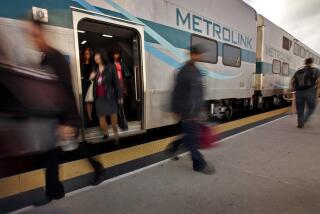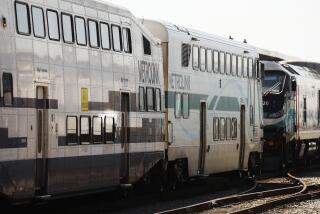Sun Blocked His Vision, Engineer Says
- Share via
The engineer of a freight train that crashed head-on into a Metrolink train killing two passengers and injuring hundreds of others on Tuesday told police he didn’t see a crucial signal before the collision because sunlight momentarily blinded him.
According to police records released Friday, Burlington Northern Santa Fe engineer Darrell Wells of Dana Point said he slammed on the emergency brakes when the Metrolink train came into view, but quickly realized it was too late to avoid impact.
“As the train approached the grade crossing in the area of Kraemer Boulevard and Crowther Avenue in the city of Placentia, Wells told me he could not see the signal” two miles before the collision, Officer Kelly Kenehan of the Placentia Police Department wrote in his report. “Wells said that the sun was very bright behind the signal and he could not distinguish the colors.”
However, parts of Wells’ account are contradicted by evidence made public this week by investigators for the National Transportation Safety Board, including the freight train’s speed and the time its emergency brakes were engaged.
NTSB officials have determined that the 67-car freight train caused the crash after running past a yellow, then a red traffic signal just before 8:10 a.m. Tuesday. Federal investigators have ruled out brake and other mechanical failure, track problems and signal malfunctions.
Placentia officials Friday released excerpts of the incident reports written by officers who arrived shortly after the accident. The reports include interviews with the freight train and Metrolink crews.
Police Friday turned over their reports to the NTSB, which has sole jurisdiction over the investigation, Placentia Police Det. Corrine Loomis said.
NTSB investigators reinterviewed crew members Wednesday and Thursday. Spokesman Ted Lopatkiewick declined to disclose what the crew members told the NTSB. The NTSB’s report is expected in nine months to a year.
Metrolink engineer Michael Dudgeon, in a written statement to police, said that as he approached the grade crossing at the intersection of Orangethorpe Avenue and Richfield Road he saw “headlights and [other] lights ahead of our train.”
“I then placed the train in emergency immediately, without hesitation,” Dudgeon said.
The Metrolink train had been powered by a rear locomotive, so the lead car carried passengers, as well as the engineer in a front-facing cab.
Metrolink conductor Patrick Phillips, interviewed at Kaiser Permanente Anaheim Medical Center four hours after the crash, told officers he heard the engineer hit the emergency brake and then saw Dudgeon dash out of the cab and into the passenger compartment of the first car.
“Phillips said he then saw the engineer run past him saying ‘Duck and tuck!’ and ‘We’re going to hit!’ or something of that nature,” according to a report filed by Officer Mike Roach.
“The engineer also had said something like ‘Santa Fe ran a red one,’” meaning the Santa Fe [freight train] had gone through a red signal.”
The engineer of the Burlington Northern Santa Fe freight told police he hit the emergency brake near the intersection of Tustin and Orangethorpe avenues, about a mile from the crash point.
As the train continued down the track, Wells said he spotted a red signal light warning him to stop, about a a third of a mile before impact.
However, NTSB investigators said the freight train’s event recorder showed that the freight train begin to brake about a third of a mile before the Metrolink train, near the red signal light. If Wells had hit the brakes a mile away, the collision might have been avoided, NTSB officials said earlier this week.
About two miles from the accident site, a yellow light signaled to the engineer that he should slow to 30 mph and be prepared to stop.
Wells told police that when he failed to see that signal because of the blinding sunlight, he slowed the freight train to 40 to 42 mph as a precaution “until he was able to see the next signal and determine what speed he should be traveling at.”
But NTSB officials said the freight train sped up after passing the yellow light, and was traveling at 48 mph when the emergency brake was applied.
Federal investigators Thursday tested track conditions using a train identical to that involved in the crash, and at the same time of day the crash occurred. They found that the signal lights were working and visible. However, NTSB lead investigator Mike Flanigon said the sky might have been more overcast Thursday than on the day of the crash.
Wells told police he began his shift near Los Angeles at 2:30 a.m. the day of the crash, and was destined for New Mexico. His departure was scheduled for 2:30 a.m., but was delayed until 7:30 a.m. because of scheduling conflicts, he told police.
BNSF officials on Friday declined to comment about the accident, and referred all inquires to the NTSB.
Results from blood tests administered immediately after the crash--a routine procedure after a major incident--showed no sign of alcohol use by any crew member.
Tests for drug use also were administered, but the results were not available Friday.
According to the reports released Friday, one of the injured Metrolink passengers was pregnant. When Kenehan entered the passenger car, he saw her lying on the floor.
“She was complaining of severe pain in her stomach, and told me that her water broke,” Kenehan said in his report. The officer said he radioed for paramedics, who quickly arrived. Her name and condition were unavailable Friday.
More to Read
Sign up for Essential California
The most important California stories and recommendations in your inbox every morning.
You may occasionally receive promotional content from the Los Angeles Times.











